Saltwater hot tubs are becoming increasingly popular by the day. Anyone can easily convert a hot tub into a saltwater hot tub, thanks to chlorine generators or seawater systems.
But are they worth the hype? Are they better than regular hot tubs? Do they save you ‘lots’ of money? Are they safe? Do they last longer? Are they easier to maintain? Is the water in a saltwater hot tub cleaner, fresher, healthier, and better? There is a lot of confusing information available online. Most of the information is contradictory, and readers can be left in a fix.
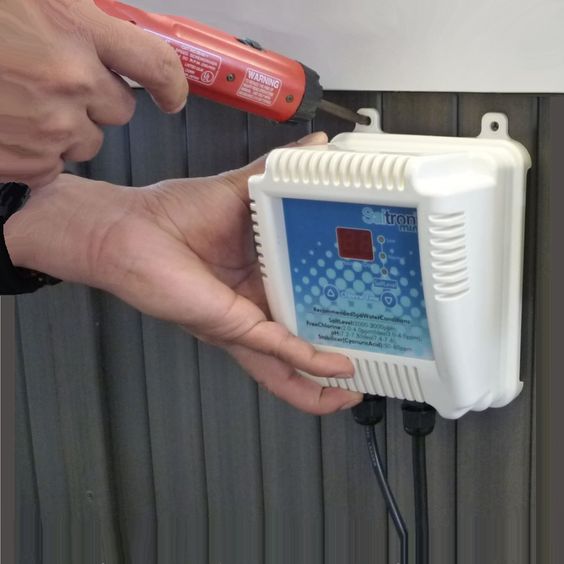
Price range: $$
Drop-in chlorinator, no plumbing required, durable titanium cell.
This article aims to delve into all the details so that you can understand everything about saltwater hot tubs. While we guide you about the numerous benefits of saltwater hot tubs, we will also highlight the inevitable risk factors. I recommend my clients to see all sides of the story. While keeping the benefits of saltwater hot tubs in mind, also consider the risks.
Freshwater vs. Saltwater: What Is the Difference?
A simple answer would be that a hot tub uses plain water and a saltwater hot tub uses saltwater, but there is much more to it. Not only do they differ technically, there are also differences in the way they operate and their maintenance requirements.
What Is a Salt Water Hot Tub?
The difference between a simple hot tub and a salt water hot tub is the addition of the salt cell chlorinator. The chlorinator releases the chlorine in salt water hot tubs; you do not need to add chemical chlorine directly into the hot tub. The chlorine released by the chlorinator dissolves to generate natural chlorine. This chlorine helps in keeping the hot tub clean, safe, and hygienic.
There are hot tubs with a built-in saltwater system, such as the Intex PureSpa Deluxe.
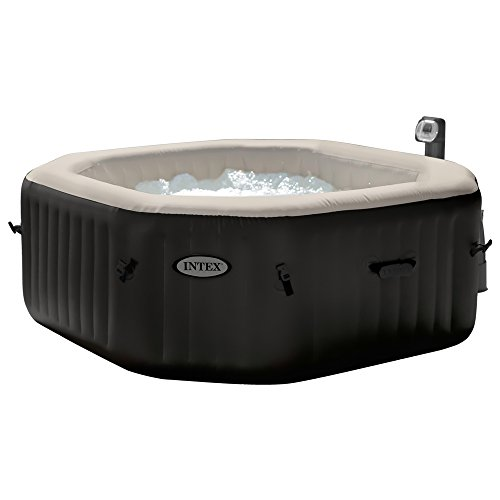
Intex PureSpa Jet and Bubble Deluxe
Winner in the category: Roominess and Comfort
Did you know you can convert any hot tub into a saltwater hot tub? There are two methods that include chlorine generators/bromine generators and saltwater systems. Chlorinators are more popular as they are at least half the price of brominators (often people don’t even know that there are brominators). Saltwater systems can produce both — chlorine or bromine depending on the type of salt you use (always read the user manuals to ensure that the salt is suitable for your device).
ControlOMatic SmarterSpa
Price range: $$$
Drop-in chlorinator, no plumbing required, durable titanium cell, self-cleaning technology.
To make the most of your salt water hot tub spa, you will need the following 10 things:
- Hot tub salt
- Saltwater test strips
- Saltwater chlorinator (drop-in)
- Spa line flush
- Garden hose
- Hose filter
- Filter cleaner
- Screwdriver
- Alkalinity increaser or decreaser
- pH increaser or decreaser
A Quick Look At Saltwater Jacuzzi Benefits and Risks:
Benefits:
- Salt water hot tubs have fewer harsh chemicals that are gentle on your skin and save you money.
- Salt water hot tubs require less maintenance, cleaning, and drainage.
- There is no unpleasant odor in salt water hot tubs.
- Salt water aids in water softness and minimizes the risk of skin problems.
Risks:
- Salt water hot tubs are not suitable for very sensitive skin.
- The initial cost of buying a salt water hot tub is higher and also the power cost increases as the temperature of the water must remain higher than 60-degrees Fahrenheit at all times.
- This system of relaxation is not eco-friendly as draining a salt water hot tub without caution can harm the environment.

How Does a Salt Water Hot Tub Work?
Saltwater hot tubs have a salt cell chlorinator installed in them (or added later, after conversion) that naturally releases chlorine into the water. Chlorine is produced from the hot tub’s salt which eliminates the need to add chlorine. A low voltage power supply is provided so that the chlorine level can be adjusted through the cell.

Source: Hotspring
Are Saltwater Spas Better Than Freshwater Spas?
Do yourself a favor and invest in a hot tub. Research has shown that it is worth it. Gone are the days when mineral or spring water used to attract people to use spas; saltwater hot tubs are now dominating the market.
There are a number of benefits that make this particular spa-type a preferred option, but there are also some disadvantages. Let’s look at the benefits and some drawbacks in detail.
What Are the Benefits of Using a Salt Water Hot Tub?
There are numerous health benefits of a hot tub which encourage anyone who can afford them to invest. Here are some of the top benefits of salt water hot tubs.
- Fewer chemicals required
One of the most significant benefits of using the saltwater hot tub is that it does not require you to constantly buy chemicals for water sanitization. Me and my team put in extra effort during the production of the hot tub, so that your salt water hot tub requires less maintenance. Salt water hot tubs require approximately 1/4th of the chemical additives as compared to other hot tubs.
- No drainage hassle
Saltwater hot tubs need to be drained once a year (compared with once a quarter draining recommendation for regular hot tubs). Salt water hot tubs get less foamy and have fewer scum lines, so the water stays cleaner for longer. This means that you are not bound to clean the hot tub after every usage; the tub would be ready to use each time.
- Passive heating
Research [5] has backed health benefits resulting from passive heating and hot tubs are, beyond a doubt, one of the best ways of getting passive heating. The study also shows that soaking yourself in hot water can help you burn calories that are equivalent to a brisk walk. Science explains that the reason is the ability of hot water to make your heart beat faster.
- Best for sensitive eyes and skin
Salt water hot tubs don’t make the eyes and skin itchy as regular hot tubs do. Chlorine is produced naturally [6] in these hot tubs and is released steadily in the water, which means that you are less likely to get cracked or dull skin after soaking in a salt water hot tub.
- Stable quality of water
The chlorine produced by the cell ensures a more stable quality of water, where you will need to spend less time balancing the water. Any hot tub owner knows that it takes up a considerable amount of time and patience to balance hot tub water.
- No nasty odor
Most of the time, people are put off from hot tubs, spas, and pools because of the odd odor; the cause of this odor is water that has been chlorinated using chemicals. A salt water system does not change the chlorine to chloramine (conversion to chloramine causes the nasty odor); when these natural chlorine molecules are used up, they change to odorless sodium chloride.
- Improved hydrotherapy
The best thing about the saltwater hot tub is that it offers all the benefits of a freshwater hot tub and more. People suffering from a disease like arthritis feel very relaxed in a salt water hot tub because warm baths helps arthritis [7] by reducing stiffness in joints, and reducing inflammation [8] of the joints.
- A comfortable experience
According to The Guardian [9], an increasing number of people are attracted to the comfortable experience offered by hot tubs and saunas. A major factor contributing to the popularity of salt water hot tubs is that people want a comfortable experience while avoiding the hassle of balancing chlorine levels. Salt water systems release chlorine gradually in the water and maintain an optimal level of chlorine.

Source: Pinterest
Disadvantages of Using Salt Water Hot Tubs
- Initial cost
Keeping other factors aside, one must not forget that the initial cost of installing a salt water hot tub is quite high. Not only is it expensive to purchase, but the replacement cost of cells can turn out to be an added economic burden. Cells last for roughly 18 months and cost somewhere between $200 to $400 for each replacement. However, you may want to bear the higher initial cost as you will end up spending less on buying chemicals later on.
- Power costs
Since the water temperature needs to be maintained in a salt water hot tub, electricity charges are going to increase inevitably. If the system has to maintain the chlorine levels by internal operation, then water temperature should not drop below 60 Fahrenheit.
- Corrosion risk
Salt water hot tubs are designed with materials that resists corrosion. However, if you have converted an ordinary hot tub into a salt water one, you need to watch out for any equipment that can corrode because of the salt water.
Debunking Myths
Whenever something starts getting attraction, rumors start spreading about it. As people start discovering more reasons to buy a hot tub, others start finding reasons to spread propaganda against it. Following are some common myths, that we are aiming to debunk here:
- No maintenance is required
I gave a hearty laugh when I heard this for the first time. True that you do not have to take the headache of adding chlorine every time when you are using a salt water hot tub, but it still requires maintenance.
It doesn’t matter how much or what you use in order to sanitize it, there will still be maintenance required. As far as the chlorinator cells are concerned, they last for approximately 2 to 3 years before they should be replaced. While salt water hot tubs make maintenance easier, you have to devote sufficient time and pay attention to proper end-to-end cleaning on a regular basis. - No chemicals need to be added
This is not true in the case of any hot tub. While you do not have to add chemical chlorine, you will still need to balance other properties like the pH and alkalinity; chlorine is naturally produced in salt water hot tubs. You also will need either a pH decreaser or pH increaser to balance the chemistry of your water. - No corrosion problems
Wherever there is salt, there is going to be a corrosion problem. Salt water hot tubs contain low levels of salinity, and that can be the reason of corrosion in metallic components, especially if there is no titanium coating. Corrosion can be prevented by wiping down the metals that are being exposed and taking care of maintaining the level of water salinity.
Salt Water Hot Tubs vs. Chlorine vs. Bromine
📝 Features:
| Salt water hot tubs | Chlorine hot tubs | Bromine hot tubs |
| Has an in-built salt cell chlorinator that produces salt water. Can be an original salt water hot tub, or a simple hot tub that has been converted to salt water. | Chlorine in the form of tablets or granules is added in the tub. Effective when it comes to sanitizing. Gives off more odor than bromine. | Bromine is required in less quantity compared to chlorine. Has the tendency to kill bacteria more efficiently than chlorine. Leads to a lower pH level compared to chlorine. |
✔️ Advantages:
| Salt water hot tubs | Chlorine hot tubs | Bromine hot tubs |
| It maintains the chlorine level naturally. Does not cause itchy eyes or skin (though, ones with very sensitive skin should be cautious). Does not produce a foul smell. | Combines with organic material and bacteria to get rid of contaminants. A chlorine system is cheaper than other options. Works quicker than Bromine to get rid of contaminants. | It is more stable in hot water than chlorine and kills bacteria and contaminants slowly. Suitable for people with naturally sensitive skin. A fair amount of Bromine still stays in the pool after the shock treatment, resulting in the requirement of a lower amount of Bromine. |
❌ Disadvantages:
| Salt water hot tubs | Chlorine hot tubs | Bromine hot tubs |
| The initial cost is quite high; also take into account the cell replacement costs that can increase the bill. Can cause erosion of metallic parts. Can be harmful to the environment [10], especially when salty water isn’t diluted. | Has a very unpleasant smell. Weekly shock treatment gets rid of the used-up chlorine, resulting in more chlorine needed every time. Not beneficial for people having respiratory or allergy issues. Can cause a skin rash [11]. | Bromine makes it trickier to balance water chemicals. Bromine can make your skin and hair rough. It costs more than a chlorine alternative. It has a characteristic foul smell too. |
🛠️How Does It Work?
| Salt water hot tubs | Chlorine hot tubs | Bromine hot tubs |
| Once the tub is installed, all you need to do is balance the chemicals. The water levels must reach the optimal level before you begin to install the salt system. | A Chlorine hot water tub oxidizes the contaminants [12]. Chlorine needs to be added on a daily basis, and balancing the water is essential too. | Bromine hot tub ionizes the contaminants. Bromine does not need to be added daily, as a sufficient amount stays in the water and performs its function. |
Conversion to a Saltwater Hot Tub:
Conversion to a salt water hot tub can be done in two ways: Drop-In or In-line method. In either method, you need to add a chlorinator to the hot tub. Chlorinator is the device that gradually releases chlorine in the water.
Drop-in Chlorinators
A drop-in chlorinator is the most convenient way to convert your hot tub into a salt water one. It does not require any permanent alterations or modifications to your spa system. It takes a few minutes to set up the whole system of salt water hot tubs. It requires a thin cord that is linked with the chlorinator cell and it hangs at the side of your hot tub.
Drop-in is considered the easiest method and is recommended by our team. You simply need to drop the chlorinator cell in your pool and fully immerse it in water. This method can be done by anyone at home – check out the two plug-n-play models below:
ControlOMatic SmarterSpa
Price range: $$$
Drop-in chlorinator, no plumbing required, durable titanium cell, self-cleaning technology.
In-Line Chlorinator
If you are not in favor of a cord hanging beside the hot tub, then you can always go for an alternative option which is the in-line chlorinator. In-line chlorinator requires to be placed directly into the hot tub system. In other words, it becomes a permanent part of your spa system.
This method requires plumbing into the existing system. This method demands special attention and expertise; the person doing it needs to know about the proper functioning of the system to make any changes.
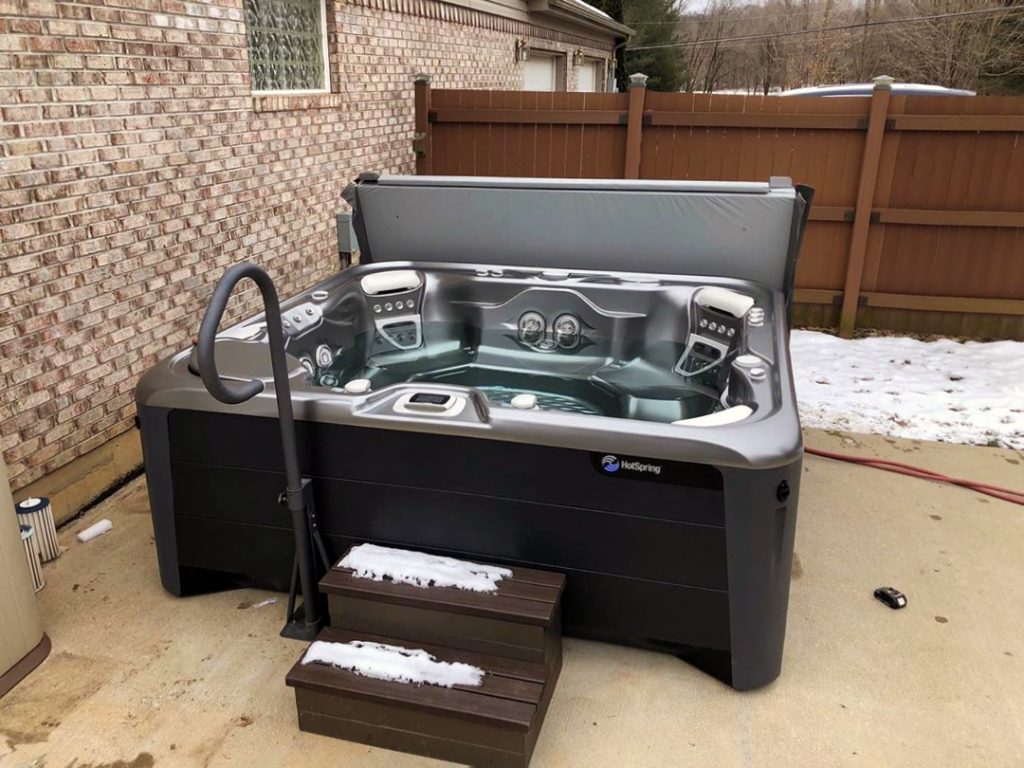
❗ Please note: If you have no expertise in installing the system, it is advised to hire a professional as carelessness in installation can cause damage to your spa system.
Conversion Kit:
To enjoy your salt water hot tub spa, you will need the following things:
1. Hot tub salt
2. Saltwater test strips
3. Salt water chlorinator (drop-in)
4. Spa line flush
5. Garden hose
6. Hose filter
7. Filter cleaner
8. Screwdriver
9. Soft cloth
10. Alkalinity increaser or decreaser
11. pH increaser or decreaser
Steps of Turning Hot Tub Into Salt Water Hot Tub:
If you are aiming to convert your hot tub into a saltwater hot tub, you will need to follow these steps:
1. Draining and cleaning the hot tub
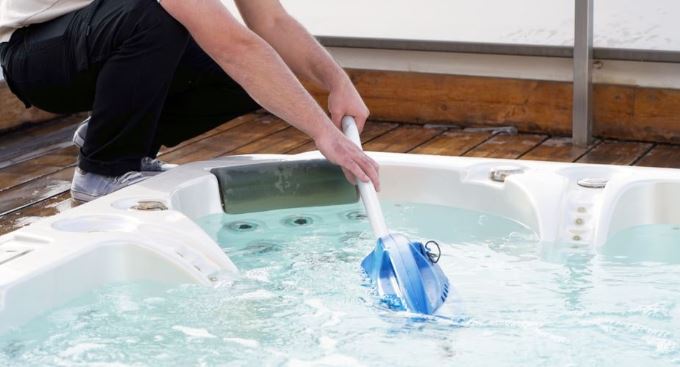
To switch from one to another, it is important to remove all contaminants and harmful residuals. You can use the line flush before the draining to clear the tub.
2. Refilling the hot tub
Next step involves the refilling of your tub, but only after you have thoroughly cleaned the hot tub. You need to link the hose filter with a garden hose. The tub should be refilled with filtered and clean water. Let the water reach the recommended level.
3. Testing, adding salt, and chemicals
Check the water for its salinity and alkalinity level, because even fresh tap water has tiny amounts of salt in it. The testing would help you in adding the appropriate amount of salt. Regular hot tub strips (that you were already using for your regular hot tub) can be utilized to check the alkalinity and pH; if they need to be balanced, do so. Add ‘Hot Tub Salt’ to reach the desired salinity level (resist the urge to add any other salt).
4. Installing the control panel
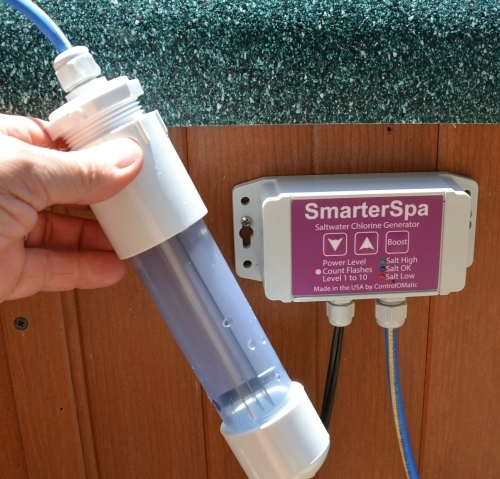
Your salt water conversion kit must contain a control panel (and associated hardware). Put the chlorinator control panel along with the hardware on any side, near the base of the hot tub. Make sure the power cable is reaching the ground-circuit outlet.
5. Attaching the cables
Link the chlorinator cell with the power supply; however, the power cord must not be plugged into the outlet yet.
6. Placing a chlorinator into the hot tub
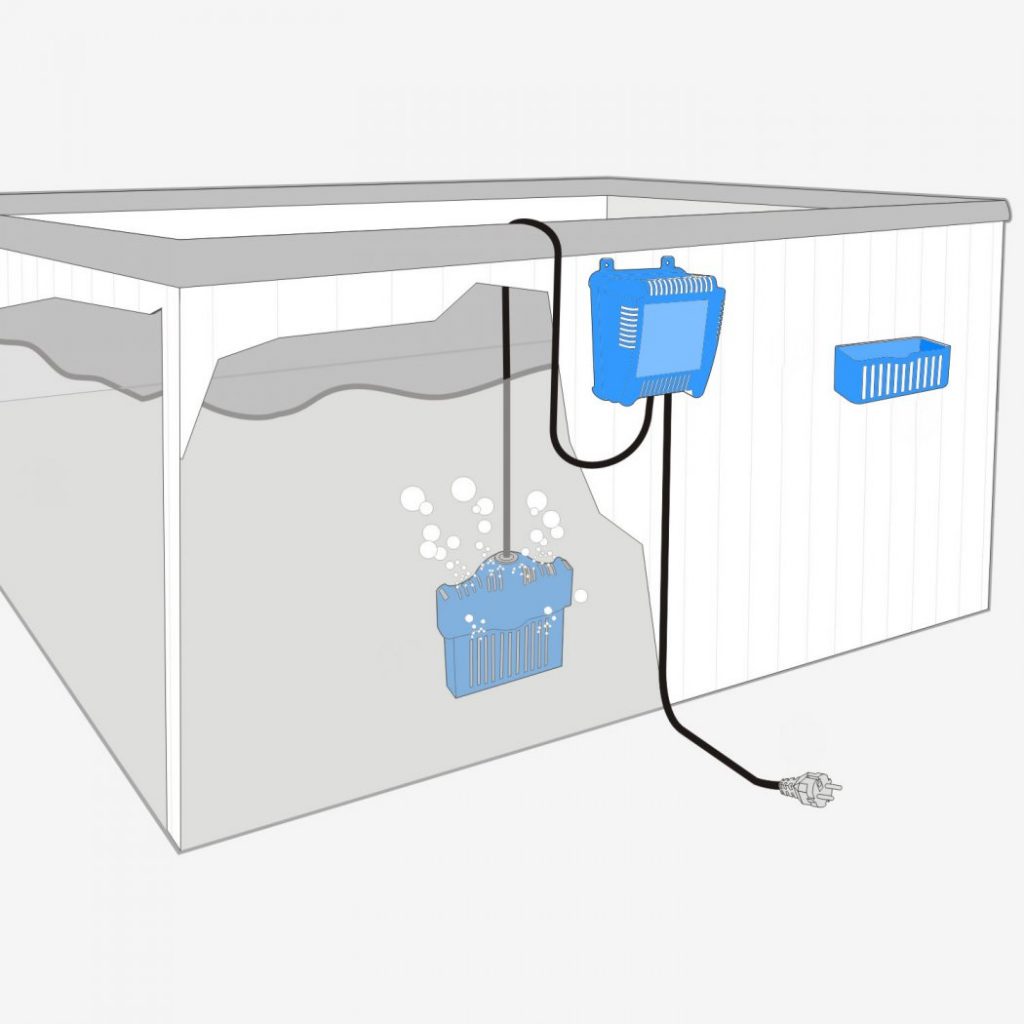
The chlorinator is what will convert your hot tub into a salt water alternative as chlorinator releases recommended chlorine level into the water. Now it is the time for you to place the chlorinator into the deepest part of your tub. This is how the sanitizer will be distributed evenly.
7. Time for you to start it
Turn on the power supply and start the chlorinator using the control panel; check the manufacturer’s guidelines on specific instructions on how to start your generator.
Now your salt water hot tub is all set to give you a relaxing effect.
Saltwater Inflatable Hot Tubs
Inflatable hot tubs are a new product in the market and according to The Guardian [13], they have already grabbed the attention of people. The significant feature of this type of tub is that they can be set up at almost any place. An additional factor towards its popularity is its low price. The main features of these tubs involve portability, durability, and ease of maintenance.
BestWay Hawaii HyrdoJet Pro
Winner in the category: Powe of the jets
Saltwater Hot Tub Reviews
1. Not much effort required
The use of salt water system does not require much effort. You only need to balance pH and alkalinity, which is really simple. According to an Amazon review [14], the headache of balancing chemicals is very low as compared to when you are using a chlorine or bromine hot tub. No mess or fuss.
2. No special maintenance required
One of the most significant points that people highlighted is that a salt water system does not require a lot of tiring maintenance. However, a review pointed out not to let anything accumulate and you are good to go; accumulation happens when there is a lack of cleaning.
3. Easier to install
Salt water hot tubs have been reviewed as an easy-to-install product. As far as chlorine and bromine water tubs are concerned, they are not only trickier to install but there are other things to keep in mind like the pH level, balancing, and adding chlorine for every use.
4. Less hassle of draining
Reviewers have mentioned a lot of good things about salt water systems. A review [15] declared that even in the duration of seven months, it required the water to be changed just once.
5. Comfortable to use
The product is highly preferable, it has no bad odor and does not lead to itchy eyes. It gives an extra softening effect to the skin. The level of salt is not high, rather it is like a teardrop [16].
Salt Water Hot Tub Pros and Cons:
Now that we have delved into all the details, let’s conclude by reviewing the pros and cons of salt water hot tubs.
| Pros | Cons |
| No chlorine hassle: It doesn’t use chlorine which saves the skin from harsh chemicals. | High initial cost: The high initial cost cannot be overlooked. It is an inevitable fact that the traditional hot tubs are way cheaper than the salt water hot tubs. It can cost you an extra amount ranging between $500 to $5000. |
| No damage to skin: The water has fewer chemical additives so you can soak to relax without worrying about harsh chemicals that can damage your skin. | Replacement charges: The cell that is installed in a salt water hot tub is not for life; it works for about two to five years. The duration depends on the quality of the cell, the number of times you use your hot tub, and lastly on your maintenance routine. |
| No redness or irritation: The chlorine added in chemical form is the culprit that causes redness to skin and irritation to eyes. A suitable amount of chlorine is gradually released and the chlorine molecules later turn into sodium chloride. | Corrosion risks: Salts can cause corrosion, especially to metallic parts. The high salt levels are the source of damaging heaters and also underwater lighting. |
| Soft water: The presence of salt in the water makes it super soft. This would definitely add to your comfort level and relaxation. | Energy cost: It costs more in terms of power to keep the water temperature above the recommended 60 degrees Fahrenheit. |
| No foul smell: Salt water hot tub does not have that foul smell associated with chlorinated water in hot tubs. |
Expert Question and Answers:
1. Can Any Hot Tub Use Salt Water?
Most of the regular hot tubs can be converted into saltwater tubs by using a conversion kit. Before converting, talk to the manufacturer to check if your hot tub supports conversion. There are two methods (drop-in and in-line) that can be used to insert the chlorinator in a hot tub to make it a salt water hot tub.
2. Can I Use Any Salt in My Hot Tub?
You will need to use 99.8% pure, granulated, and non-iodized sodium chloride salt. The best would be to buy specialized hot tub salt.
Avoid adding table salt, sea salt (or any other salt), as those kinds of salt can contain other chemicals that can damage your hot tub and void your warranty.
3. Are Salt Water Hot Tubs Good for Your Skin?
Yes, salt water hot tubs are a source of skin softening because the water has fewer harsh chemicals. They cause no skin issues except for very sensitive skin types. Added advantages are the healing, relaxing, and therapeutic qualities of salt.
4. How Much Does a Salt Water System Cost?
The price range of a saltwater system can range from $500 to $5000, while the price of a new salt water hot tub can be anywhere between $2000 and $32000.
5. How Often Should I Change the Hot Tub Water?
The manufacturer’s guideline will reveal the exact duration. User reviews have mentioned that salt water hot tubs can last about 7 to 12 months before they need to be drained and refilled. It is advisable to drain water from a regular hot tub every 3 months; however, salt water hot tubs can last longer before the water needs to be replaced.
6. What Kind of Salt Can I Use in the Hot Tub?
A sodium bromide salt water hot tub will use bromine, while a sodium chloride saltwater hot tub will use sodium chloride. Manufacturers can provide the recommended hot tub salt which works best with the model that you have purchased. Again, always use hot tub salt and refrain from using any alternative salt.
7. Can Epsom Salt Be Used in a Hot Tub?
Epsom salt is NOT a good option for salt water hot tubs as it leads to corrosion. Epsom salt is a good option for a foot bath or a bathtub, but not a hot tub.
8. How Do I Adjust the Sodium Chloride Levels in a Salt Water Hot Tub?
You can use salt water test strips for this purpose. If the strips show a low level of chlorine, then add 225 grams salt, let the water circulate, and then retest. Common salinity requirement is 2500ppm (check specific number for your model).
9. What if I Add Too Much Salt in My Hot Tub?
If you have added more salt than recommended in your salt water hot tub, the simplest solution would be to drain some of the water and refill with fresh water. Once done, let the water circulate for a while before testing to check if the salt level has dropped to the recommended level.
10. How Much Hot Tub Salt Do I Need?
There are different variants of hot tub salts and their costs vary accordingly. On average, a salt water hot tub uses roughly $7 worth of hot tub salt in a month. The actual amount you will need will depend on the manufacturer’s guidelines and the existing salinity level of your water.
Summary
Salt water hot tubs are costly to purchase (or convert) but save you money in the long run when you have to buy fewer chemicals; however, do not forget to take into account the power costs and cell replacement costs.
There are health benefits of soaking in salt water hot tubs but do not forget the points of caution. While the tubs use fewer chemicals, salt water hot tubs are not entirely chemical-free. They do decrease the burden of maintenance, drainage, and cleaning – yet you still have to do all three.
So, while it is true that certain characteristics give salt water hot tubs an edge over regular hot tubs, there are also downsides that you should be aware of before you make the all-important decision of buying a saltwater hot tub or converting your hot tub into one.
FAQ
🙋♂️ How does a saltwater hot tub work?
You have to add salt to the hot tub’s water instead of adding chemicals. There is a chemical reaction that takes place between the salt and the water known as electrolysis. Saltwater systems provide the hot tub with a constant supply of chlorine or bromine. Once it decomposes back to salt, the process restarts since the salt does not evaporate from the water.
👌 Can any hot tub be a saltwater tub?
Every hot tub can be converted to a saltwater tub because saltwater systems utilize the same sanitizers used in hot tubs. Slightly salty water will not damage your equipment, although you should ensure that the salinity is within the normal range (2000-3000 ppm). Check with the spa manufacturer to determine if this conversion will void your warranty.
💲Are saltwater hot tubs more expensive?
The initial cost of a saltwater hot tub is always higher because it requires saltwater chlorine or bromine generators. But, the maintenance is cheaper than the maintenance of a traditional hot tub. You don’t need to add chlorine or bromine on a regular basis. You need to add salt when you fill the hot tub with water and the system utilizes this until the water is replaced. (from 3 months up to 1 year depending on the intensity of usage).
⚠️ Will Epsom salt ruin a saltwater hot tub?
Yes! It can damage your hot tub, mess with your pH balance, and even burn your skin. Use a special pool salt that is at least 99.8% pure and marked as compatible with chlorine/bromine generators.
References
Blessing, J. (2019). Sea Salt in Hot Tubs. Retrieved from Our Everyday Life: https://oureverydaylife.com/how-to-keep-bathwater-hot-12561258.html
Ellis, M. E. (2017, May 8). Natural Relief From Arthritis Pain. Retrieved from Health Line: https://www.healthline.com/health/osteoarthritis/arthritis-natural-relief
Faulkner, S. H., Jackson, S., Fatania, G., & Leicht, C. A. (2017). The effect of passive heating on heat shock protein 70 and interleukin-6: A possible treatment tool for metabolic diseases? Temperature, 292-304.
Fullerton, A. (2019, May 8). David Cameron buys £8,000 wood-fired hot tub so he can chillax in his luxury £2m Cornish retreat while Theresa May is still in hot water over Brexit. Retrieved from The Daily Mail: https://www.dailymail.co.uk/news/article-7003821/David-Cameron-buys-8-000-wood-fired-hot-tub-luxury-2m-Cornish-retreat.html
Lamothe, C. (2017, October 13). Can a Hot Bath Deliver the Same Results as Exercise? Retrieved from Health Line: https://www.healthline.com/health/chronic-pain/hot-bath-benefits-sento-furo-japanese-bathing#1
McCarthy, F. (2019, May 15). Hot tubs, saunas and seaweed soaks on Ireland’s west coast. Retrieved from The Guardian: https://www.theguardian.com/travel/2019/may/15/saunas-seaweed-ireland-wild-atlantic-west-coast-swimming
Render, J. (2019, May 21). Saltwater hot tub pros and cons. Retrieved from Consumer Affiars: https://www.consumeraffairs.com/homeowners/saltwater-hot-tub-pros-and-cons.html
Rossi, P. (2019). 11 Research-backed Reasons to buy a Hot Tub. Retrieved from By Rossi: https://byrossi.com/11-research-backed-reasons-to-buy-a-hot-tub/
Rossi, P. (2019). Full List of Hot Tub Health Benefits – According to Doctors And Researchers. Retrieved from By Rossi: https://byrossi.com/all-hot-tub-health-benefits/
Staff, K. N. (2019, May 06). Preparing for pool season the right way. Retrieved from Salmon Arm Observer: https://www.saobserver.net/news/preparing-for-pool-season-the-right-way/Stieg, C. (2019, May 22). What It Means If Hot Tubs Give You A Rash. Retrieved from Refinery 29: https://www.refinery29.com/en-us/hot-tub-folliculitis-rash-treatment
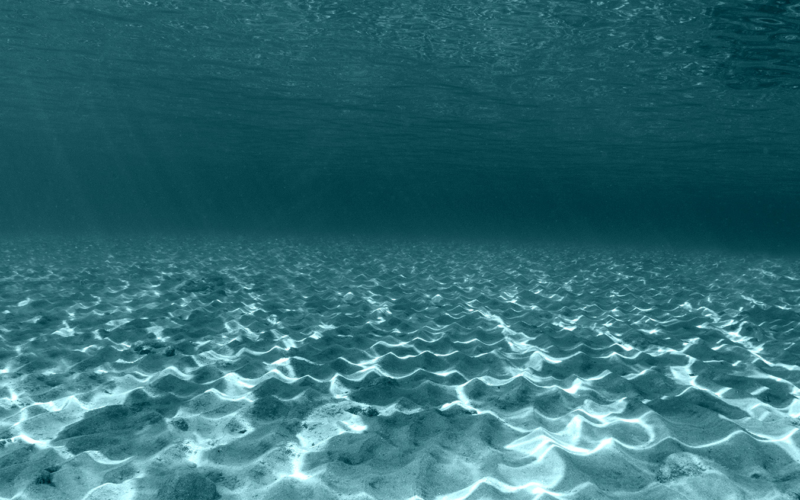

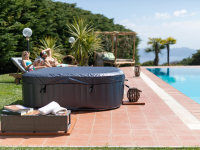


We have a 4 person salt water jacuzzi anddo not know how much salt to add and how often?
Michael, all you need is to maintain your salt at 2000 – 2500 ppm and test water every 2–3 days to ensure it stays healthy. Happy hot tub chill!